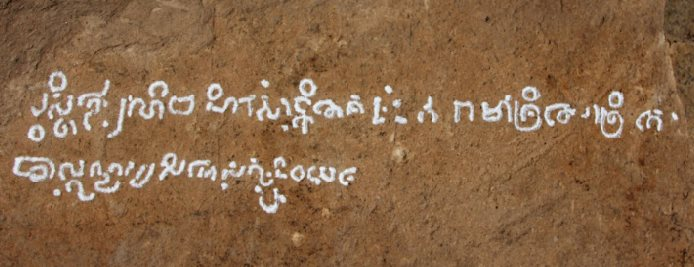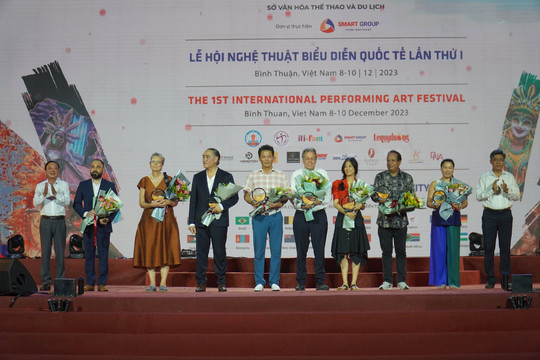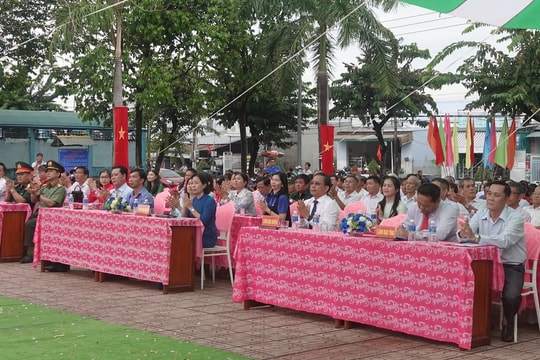New excavated discoveries
In the early twentieth century, French archaeologist Henri Parmentier, specializing in research on Champa culture, surveyed and studied the Po Dam tower. Because there were no conditions for excavation, when he came here he only surveyed and drew the structures on the ground and concluded that this group of towers only had 6 towers, the 2 northern towers collapsed, and the remaining base of the brick tower was about 1 meter high.

Sanskrit inscription on the stone
More than 100 years later, Vietnamese archaeologists discovered two new tower bases. Both are located in front of tower group B to the south. They collapsed and were buried many centuries ago therefore no one knows. One has a base of up to 16.30m long and a width of 6.95m. That is the remains of a tower with the longest length discovered for the first time here and from Binh Dinh province to the south. While all other Cham towers in Binh Thuan and Vietnam Central mostly have square or nearly square plans, with one main door facing the East, these tower has 2 doors, one facing the North and the other facing the South. In total, the Po Dam tower group has 8 towers; 4 towers collapsed and 4 towers have been restored to their original appearance.
In addition to the ruins of tower bases and other architectural parts found with very diverse and complex structures belonging to many different stages of architecture and use, the excavation results also discovered a huge amount of stone relics, ceramics, terracotta, metal, and a grinding table (pesani – rasun batau) with a very different shape compared to the type of grinding table often found in Champa culture.

Golden Linga is an important discovery of this excavation.
A stone inscription engraved in Sanskrit, an ancient Indian language, dates to the year 710 (early 8th century). It can be seen that this stele is a very important discovery, from the content engraved, the historical, artistic values of the tower group's architecture, and even the date of some other Cham towers are clarified and objective.
Belief and religious activities were carried out many centuries ago here through the collection of metal relics, including items made from different materials such as gold, brass, iron, ceramics, and musical instruments. Bronze includes bells, cymbals, and rattles. The two-ring jewelry is a popular type and identifies Champa culture (muta ring); 1 bronze mirror fragment originating from China. A bronze ruler in the middle of the four square edges has many engravings on all four edges with different symbols. The two rounded tips are a proportional ruler for building the tower. This is an interesting and scientifically valuable discovery in the architecture and construction process of the tower. These have great value in both the tangible and intangible culture of the ancient Cham.
A golden Linga has been discovered
On a mid-June afternoon in the year of Quy Ty (2013), like every other excavation day. While digging the layers of soil outside the wall of the North Tower, one of the workers discovered something golden below the soil layer mixed with gravel and broken bricks about 50cm. The supervisor of the excavation group, Mr. Uong Trung Hoa (Provincial Museum), and experts at the Institute of Social Sciences reviewed and did some technical operations. Later, he brought up a golden metal relic. The group of workers at the excavation site knew nothing except it was gold.
Due to the confidentiality of the relics, after creating a record at the scene and other procedures according to the decision to allow excavation by the Ministry of Culture, Sports and Tourism. The golden relic was escorted to the Provincial Museum that night. Through examination, scientists confirmed that this is the head of a Linga made of pure gold (the gold of high purity, unlike the young gold bowls discovered at Po Klong Garai tower in 1984 in Phan Rang). Linga is a work of art that a jeweler has created; A masterpiece full of the aesthetics of our predecessors, demonstrating the talent, intelligence, and creativity of Cham identity in the field of religion. It was dated around the 8th century - the same date as the construction of the Po Dam tower group.
Linga has the following dimensions and measurements: Height 6.4cm; middle width 5.7cm; outer diameter 5.7cm; circumference 17cm; weight 78.3630g (inspection results of Quality Measurement Technical Center 3 of the Ministry of Science and Technology). Compared to the gold Lingas discovered in Champa relics or Oc Eo culture, the gold Lingas at Po Dam are much bigger and have much gold content. However, the main value of the Linga in Po Dam does not depend on 78.3630g of pure gold but it was on the Linga's structure, origin, age, rarity, and craftsmanship.
Linga is cast from a mold, not mounding or embossing like most gold relics discovered in Oc Eo culture (Ba The - An Giang) or the Cat Tien temple tower area - Lam Dong. The special thing is that Linga was discovered in the excavated strata. The details on the Linga are round, the inner and outer body are smooth, the sole runs thin borders are very delicate. This proves that in the past, Cham craftsmen had reached a master's level in the art of jewelry. Up to now, it can be seen that the Golden Linga at Po Dam is one of the rare works known in Champa art in general and Binh Thuan in particular. Along with other unique relics such as inscriptions, bronze rulers, bronze mirrors, and musical instruments... the golden Linga is an important discovery of this excavation.
Research on the culture, religion, and beliefs of the Champa kingdom during its prosperous periods shows that each king, after ascending the throne or achieving a glorious victory, often built new or renovated old towers, casting a Golden statue dedicated to Lord Shiva, the supreme deity. Those had to be the most important and precious gift that the Champa kings offered to Shiva. The golden Linga in Po Dam is one of them. The Shiva god in the Po Dam tower is embodied in the idol Linga-Yoni worshiped in the North tower group that Henri Parmentier described in the early 20th century. This is also a special relic chosen by the Department of Culture, Sports, and Tourism to prepare a dossier to submit to the National Heritage Council for approval and recognition as a national treasure.






.jpg)



















.jpeg)

.jpeg)


.jpeg)


